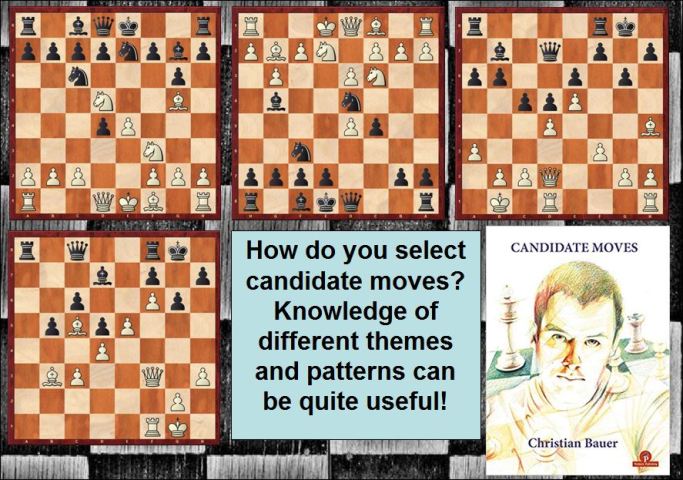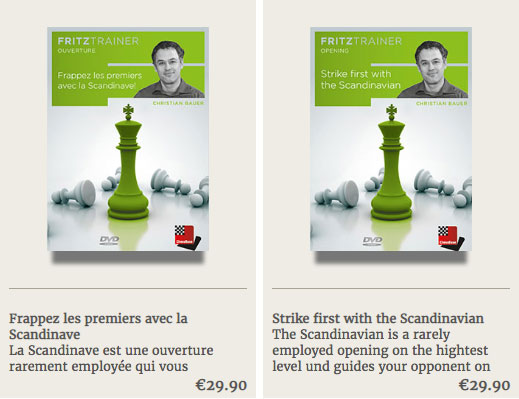


Strike first with the Scandinavian
The Scandinavian is a rarely employed opening on the hightest level und guides your opponent on much less familiar terrain than for example the Sicilian, French or any 1.e4 e5 system. After 1.e4 d5 Black fights for the initiative from move one.
I had the pleasure of reviewing a ChessBase DVD made by GM Christian Bauer on the Scandinavian. He is likely the top world expert on the 1.e4 d5 2.exd5 Qxd5 3.Nc3 Qa5 Scandinavian.
I was very pleased to see this GM personally explaining the opening he loves. So when his latest book came out I was quite curious to see what he could teach me about a topic which is really important.
For example, one of the books everyone talks about (as there are trends in the openings, there are trends also for books, independent of their objective merit) is Calculation by Jacob Aagaard.
 The problem with that book, in my opinion, is: how could I use a calculation book, if my "algorithm" for selecting the candidate moves is wrong? Yes, this is a case when what to learn first is important and if not fundamental to the development of a player.
The problem with that book, in my opinion, is: how could I use a calculation book, if my "algorithm" for selecting the candidate moves is wrong? Yes, this is a case when what to learn first is important and if not fundamental to the development of a player.
Many books have been written on the topic of Candidate Moves; off the top of my head, I remember one by Andy Soltis and another with Karpov's name on it.
Is this book by Bauer about going to help a tournament player to find the best move in every situation? The answer is: No.
The book is a collection of games played by Bauer, in which he adds a rather original idea: he analyzes the game first from the white side and then the same game again — but with his thoughts on the black side. Why does the author try this unusual teaching method? Because he correctly noticed that the point of view from which one is seeing the game, combined with the individual tendencies of the player (be they psychological or formed from intrinsic chess knowledge), often influences the "choices" (or candidate moves) one considers when playing. So through the effort of analyzing these games from both sides, dedicating to each side an entire game, he hopes the reader will become less subjective in his/her own games, and more objective overall. The goal, as always, is gaining a better understanding of the move to choose when playing a tournament game, through understanding and replicating the thought process of a professional player.
The author, throughout the book, also tries to "connect the dots" for us amateurs, showing a multitude of patterns and themes we should know. Pattern recognition is important as well since the plans and the subsequent choices of candidate moves are influenced by the patterns we know.
Clearly, this book is not written for the low-rated amateur or low-level player who still misses basic tactics and checkmate/endgame patterns. This is a book written with the goal to improve the chess mind of a player who already has a clear grasp of the basics, and is working toward master level.
The book is made up of four chapters, with different themes:
The "Mega" is the database every serious chessplayer needs. The database contains 7.1 million games from 1500 to 2017, in highest quality standard, full of top level analyses and completely classified.
I have transcribed one game, and received another from Thinkers Publishing for the readers of this review, so they can understand the level of the annotations for each game, and how good the ideas are. If possible, one should analyse them on a board, oriented by the side the game is dedicated to. GM Romain Edouard (Thinkers Editor-in-Chief) told me they continue to improve the translation of the books and the editing — so the annotation could be outdated compared to the one found in the actual printed book.
Click or tap the second game in the game list to switch games
ChessBase account users can download the PGN and analyse with ChessBase 14 or ChessBase Reader 2017.
Everyone uses ChessBase, from the World Champion to the amateur next door. Start your personal success story with ChessBase 14 and enjoy your chess even more!
Along with the ChessBase 14 program you can access the Live Database of 8 million games, and receive three months of free ChesssBase Account Premium membership and all of our online apps! Have a look today!
As a reviewer, I have to point out a mistake lest readers think I'm lazy, although frankly this one is just silly — it doesn't change the core value proposition of the book which is more important, in my opinion. For example on page 20, "was the standard move order of the Giuco Piano" "Giuco" is wrong. Today in Italian we use the modern word "Gioco" but at that time, the old word used was: "Giuoco." Italian is a language full of vowels, the real language of Love. So the editor or author missed a vowel — obviously not a big deal.
The Bishop's Opening and The Italian Game
Studying the content of this DVD and adding these openings to your repertoire will provide players with a very strong tool to fight 1...e5 - as the practice of the author clearly demonstrates.
On the other hand, this book is definitely modern — the author in the preface (page 7) used a smiley through the characters [something ChessBase gives a :( -Ed.]. Clearly, society and language are developing faster than what our grammar teachers taught us in school. It is refreshing to see a publisher who is modern and doesn't bow to the constraints of grammar rules which limit novelties language usage.
I do have one criticism which is instead more serious, and more significant. The author of this book offered a new approach, which I haven't encountered in any chess book before (and I've reviewed roughly 30 books in the past year). He created a game collection where the games are seen from two different viewpoints, once as White and once as Black. Unfortunately, all the diagrams of the book, even for the games ostensibly seen from the Black viewpoint are oriented (as in almost every chess book I've seen lately) from White's side. Honestly, in our technological age, I don't understand why it's not common practice for publishers to orient the diagrams from the correct side in cases like this where the reader is explicitly told to consider a position as Black.
Speaking of diagrams, the publisher prints analysis diagrams throughout in a smaller size to differentiate from these diagrams inserted by the author at critical points from the main lines. However, I found the analysis diagram to be a little too small for my eyes. Of course, others may disagree and it depends somewhat on the target audience.
The book doesn't have exercises, leading me to wonder whether a reader who has studied, for instance, Chapter 1, can be sure he or she understood the ingredients of the exchange sacrifice and will be able to put it in practice in tournament games.
It would be interesting if Bauer would create a companion for this book, comprised solely of exercises based on the four chapters. It could have 50 positions for "exchange sacrifice", 50 for "tactical mess", 50 for "king in the center", and 50 for the last chapter on the subject of "quieter games".
On the other hand, there are ways of making one's own exercises which can be a useful activity in itself. This position comes from game 3:
Try to put it on a real board and analyze what happens after 20.Nf5! Then give an evaluation. What are the alternatives? This position will show you how long it would take in a real tournament game to play the correct move, and test how well you are at visualizing the tree of the variations.
This is one way we could use this book to create custom exercises; open the book to any game, and just pick one of the many diagrams, wisely interspersed by the author throughout the annotations. Then think about the position for 10 minutes, and see if the same moves you come up with were played in the game, with similar plans or ideas. Nevertheless, this may not a congenial method to many readers.
For example, Game 7 which one can find below, wasn't notated through to the end. GM Bauer says White stands much better, but it would have been too early for Black to resign. Try to continue the game from the last move, let the engine answer, and see if you are able to win as White.
Here is the game:
You have several opponents to choose from: the default is "beginner" but you can switch to "serious amateur", "club player" or "master"
Now play 38.Rd4, and see for yourself if you can beat Fritz set at master level.
I like GM Bauer's idea; I think it was really original and I wish more chess authors would adopt it because often in the chess publishing market we just see the same books over and over, without a minimum of creativity — they could be made in 30 minutes with ChessBase. Instead, this book is clearly "new," so we must praise the author for that, as well as the publisher for taking the risk.
We must never forget publishers do take heavy financial risks for trying to be innovative in the market and giving us the best quality. (Speaking of quality: the paper used for this book is really pleasant — or, if I may use an adjective which came to prominence last year from the interview between Ashley and Carlsen, this paper is really smooth!
Strike first with the Scandinavian
The Scandinavian is a rarely employed opening on the hightest level und guides your opponent on much less familiar terrain than for example the Sicilian, French or any 1.e4 e5 system. After 1.e4 d5 Black fights for the initiative from move one.
 Candidate moves, a Grandmaster's method
Candidate moves, a Grandmaster's method
Christian Bauer
405 pages
2018 Thinkers Publishing
Thinkers Publishing also has a set of three volumes only on exercises: They are called Chess Calculation Training, and I suggest they should be read after this book, to try to practice what this author is teaching us.
